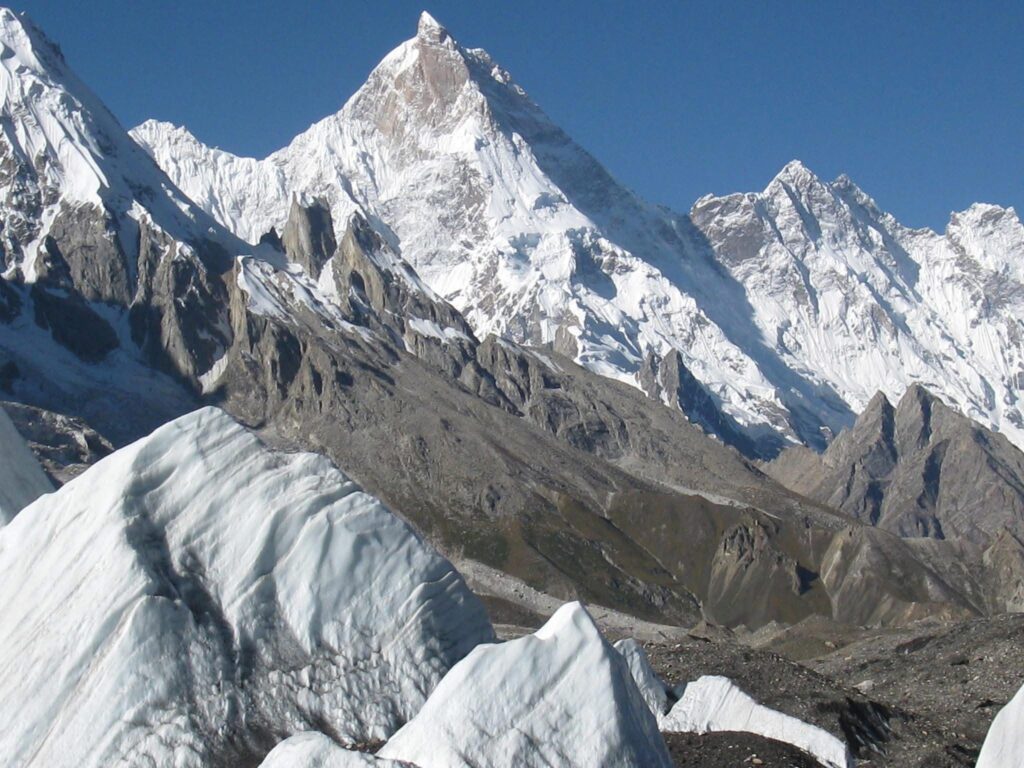Climbing Masherbrum: One of Mountaineering’s Greatest Challenges

Masherbrum, known as K1, is often overshadowed by its towering counterparts in the Karakoram Range, such as K2 and Gasherbrum.
Yet, to mountaineering enthusiasts and seasoned climbers, this 7,821-meter peak holds a mythical allure.
It’s the kind of mountain that demands everything from those who dare to climb it and offers a sense of accomplishment that few other summits can rival.
Whether you’re an experienced climber or simply fascinated by the world of mountaineering, this guide will explore why Masherbrum is considered both an enigma and a challenge.
From its climbing history to its technical difficulties, here’s everything you need to know before setting your sights on this formidable peak.
What Makes Masherbrum Extraordinary
A Karakoram Icon with Historical Significance
Masherbrum, located in the Ghanche District of Gilgit-Baltistan, Pakistan, is the first peak in the Karakoram to be officially mapped, earning it the designation “K1.”
Its towering summit and striking prominence make it a visual standout, even in a region dominated by 8,000-meter giants like K2.
The mountain’s name adds to its enigmatic charm. While its exact origin is debated, possibilities range from the Balti word “mashadar” (muzzle-loader) to the poetic moniker “queen of peaks.”
Either way, Masherbrum remains an object of fascination for climbers and historians alike.
A Peak for the Bold and Brave
With an elevation of 7,821 meters (25,659 feet), Masherbrum ranks as the 22nd-highest mountain in the world and the 9th-highest in Pakistan. However, the challenge lies in its height, technical routes, and unpredictable weather.
This peak has earned a reputation for being one of the most difficult mountains to climb. Its Northeast Face, in particular, is considered one of the toughest big-wall climbs in the world.
Vertical slopes, constant avalanches, and extreme exposure push climbers to the brink, testing their physical and mental endurance as few other mountains can.
Climbing History of Masherbrum
Early Attempts
The first recorded climb of Masherbrum occurred in 1960, accomplished by an American-Pakistani team led by George Bell and Willi Unsoeld. Using the Southeast Face route, this expedition marked a milestone in high-altitude climbing.
Pakistani climber Jawed Akhter also summited during this expedition, making it the first successful ascent by a Pakistani.
Despite its early success, Masherbrum continues to see far fewer summits than many peaks of its caliber.
Only a handful of expeditions have reached the top since 1985.
The Unclimbed Faces
While the Southeast Face has seen limited success, Masherbrum’s other aspects, particularly the Northeast and West Faces, remain unconquered and are considered monumental challenges.
Climbers like David Lama and Marek Holeček have scoped out these difficult routes, but the combination of technical difficulty and extreme danger—think constant avalanches and vertical ice—has deterred even the most elite teams.
What Makes Climbing Masherbrum so Challenging?
1. Extreme Technical Difficulty
Masherbrum’s faces are highly technical, with near-vertical ice walls, mixed climbing sections, and exposed ridges. The Northeast Face, often compared to a combination of the Eiger’s North Face and Cerro Torre, is particularly treacherous.
Climbers are required to master a blend of rock, ice, and mixed climbing techniques while navigating terrain that is unforgiving at best and life-threatening at worst.
2. Unpredictable Weather
The Karakoram Range is infamous for its unpredictable weather, and Masherbrum is no exception.
Sudden snowstorms, high winds, and whiteout conditions are common, turning even well-planned expeditions into perilous ventures.
Many climbers have been forced to retreat due to deteriorating conditions, sometimes within sight of the summit.
3. Avalanche Hazards and Serac Fall
Masherbrum’s positioning elevates the risk of avalanches and serac falls, especially on its lower slopes. Climbers must move quickly and efficiently through these “shooting galleries” to minimize their time in harm’s way.
4. Thin Air and High Altitude
With Base Camp itself sitting at 4,800 meters, Masherbrum pushes climbers into extreme altitudes early in their ascent. Proper acclimatization is essential, but the combination of thin air and strenuous climbing can take a significant toll on the human body.
Preparing to Climb Masherbrum
A successful Masherbrum expedition requires months, if not years, of meticulous preparation. Here are some key considerations:
Physical Fitness
Training for Masherbrum involves building strength, endurance, and technical climbing skills. Regular training at altitude can simulate the conditions you’ll face on the mountain, helping your body adapt to reduced oxygen levels.
Technical Skills
Proficiency in mixed climbing, glacier travel, and crevasse rescue is non-negotiable. Given the technical demands of Masherbrum’s routes, climbers must also be comfortable with steep ice and rock climbing in extreme conditions.
Planning and Logistics
Expeditions to Masherbrum often last several weeks. You’ll need to arrange permits, equipment, and support staff, including porters and possibly experienced mountaineers familiar with the mountain. Partnering with a reputable expedition company can simplify this process.
Mental Preparation
Masherbrum tests not only your physical limits but also your mental resilience.
Remaining focused and composed in the face of adversity is crucial. Many climbers recommend meditation or mental training techniques to prepare for the psychological challenges of high-altitude climbing.
The Legacy of Masherbrum
Masherbrum holds a unique place in the annals of mountaineering.
It is a peak of legends, a proving ground for the boldest climbers, and a mountain that commands respect.
While its slopes remain largely untouched, the allure of its unclimbed faces continues to inspire climbers from around the globe.
Are You Up for the Challenge?
Climbing Masherbrum isn’t for the faint of heart—it demands unparalleled skill, preparation, and determination.
Yet for those who dare to take on this challenge, the reward is a summit and a place in mountaineering history.
Whether you’re building up your climbing skills or simply dreaming of your next adventure, Masherbrum represents the pinnacle of what the human spirit can achieve.
